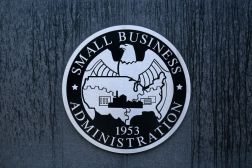The man behind SBA’s $6.5B annual give away for startups

Silicon Valley may seem like the capital for tech startups and angel investing. But for Mark Walsh, who has made a career of piloting and funding tech startups, nothing quite matches the opportunities he’s seeing now at his offices a few blocks away from the U.S. Capitol in Washington, D.C.
Walsh has had a knack for getting in on the ground floor and building technology and media businesses, starting at Home Box Office in the early days of pay-TV. He later led an online business for General Electric, oversaw enterprise business development at AOL as the internet began taking off, and took public an online business-to-business procurement platform called VerticalNet.
Since then, he has been involved as an angel investor, board director and advisor to a variety of firms.
But a chance call from an old colleague eventually led to a pitch Walsh couldn’t turn down: to head up the Small Business Administration’s Office of Investment and Innovation where he helps dole out $6.5 billion annually in seed capital and loans to promising startups through the agency’s Small Business Innovation Research, or SBIR, program and Small Business Investment Co., or SBIC.
The agency’s funding has helped lift a variety of innovative ideas literally off the ground, from 3D printing in space to airborne wind turbines that can supply energy to remote locations. It has also provided seed funding for all kinds of other startup ideas, including bioplastics generated from waste materials, robotic buoys and educational tools designed by women developers.
Seed money from SBIR helped launch major tech companies like Qualcomm and Symantec.
FedScoop met with Walsh at his Washington office, ahead of the SBIR’s National Innovation Summit, May 23-25, to talk about what persuaded him to move from private sector finance to a job working for the federal government last November –—and why more startups aren’t taking advantage of what the SBA can offer.
Editor’s Note: This interview was edited for clarity and length.
FedScoop: Why did you say ‘yes’ to coming to the SBA?
Mark Walsh: I talked to people here and some outsiders who know this zone, and they told me, ‘This is the best job in the United States government.’ Because you have money, you have the will and the power and the authorization to interact with really significant investment professionals in the private sector – and technology startups. So you can really get stuff done rapidly.
I mean no disrespect to the rest of the U.S. government, but managing bureaucracy is not my skill set. I’m actually interacting with everybody in my Rolodex. And I’m getting to know these really cool people that I would have tried to get to know anyway.
I love the fact that the SBA is kind of a stealth organization. A lot of government is in the ‘no’ business — because they’re regulators, saying, ‘You can’t to this and that.’ We’re in the ‘yes’ business. A whole chunk of the SBA is about handing money to smaller businesses. But my world is for big venture capital and private equity funds.
So if there was ever a time and ever a place to join the federal government, this was it – especially with the president in his last year, when he’s really trying to break some glass, and take some directional commitments that map against my innovation background.
FS: What surprised you most about moving from the private sector to the federal government?
MW: Everything I was hoping to see in the government I see ‘times-ten’ – way, way more expertise, commitment, savvyness, market knowledge. It really blew me away. There are people on my team that could resign tomorrow and go to work for Goldman Sachs for 15-to-50 [times] their current salary. But they don’t. We all have reasons for what we do. I love the fact the U.S. government has people that do incredible work.
Everything I was hoping not to see, I also see ‘times-ten.’ Things that many people are critical of the U.S. government about: bureaucracy, [a culture of] ‘that’s the way we’ve always done things here.’ My whole career has been high change-rate environments with a high appetite for risk, so I’m the wrong guy to judge traditional complex behavior at large organizations.
FS: SBA has a lot of money to dole out, relatively speaking, that a lot of people either don’t know about – or perceive a lot of obstacles to getting it. What’s your perspective on what’s preventing more of the market from taking advantage of what the SBA has to offer?
MW: This is the question of the ages. The U.S. government is a very bad marketer; they’re the government — they’re not supposed to be good at marketing. So part of my job and my team’s job is just getting out and making sales calls. It’s really just outreach. It’s really amazing how few people know how many dollars are available to professional investors in the SBIC side and to innovative startups and seed capital arenas on the SBIR side to fuel great stuff.
As for the second part of your question, even if they know, are they worried about the paperwork and the process? And sadly, the answer is, they should be.
We do ask for a lot of information from our applicants; we do have a lot paperwork [delivered] the old way, because that’s the way we’ve always done it. So we’re trying like hell to reduce the amount of time and streamline the process to make applying for SBIC or SBIR funds smooth, painless and productive. We’re trying to get better at short ‘no’s’ and faster ‘yesses.’
At the same time, we’re trying to make the interaction after you get our money be smoother. Once we’re partners, we ask [applicants] to file documents which can be onerous.
I’ll one add more thing: Some people are afraid of being in business with the government, because it’s the government and they don’t want the government to know everything about their efforts. And I get that.
FS: How would you describe the sweet spot of the kind of companies that fit the profile of what SBA is willing to fund? Is it companies that can benefit the government, or the U.S. economy?
MW: Actually it’s both. We have two buckets: SBIC and SBIR.
SBIRs are startups and seed capital environments that will help the government and the private sector citizens at the same time. We give out Phase 1 and Phase 2 cash grants – no equity, no debt, you own it – for ideas and discoveries and software and technology platforms that are mapped against the need of another agency in government.
So the [Defense Department] says they need new Kevlar weaving for bulletproof vests. We will find an opportunity with a bunch of bench chemists, or a start up company, and we’ll fund them with cash grants that A) prove that their weaving is better and B) prove that they can scale and commercialize so they can make a lot of it, and C) introduce them to the customer at DOD who’s going to buy a lot of those vests. It’s a true grant system, but there has to be a target [agency] customer at the end of the process. It’s unbelievable how broad the needs of government agencies are.
A quick example: Roomba, that little round [robot] vacuum – that was an SBIR grant, about $1.7 million. The Department of Defense needed a technology and a device to search caves and open fields for land mines. So Roomba actually began as a little land mine searcher. It knows where it’s been.
We’ve got thousands of stories like that. Probably two-thirds of the [technologies in the] mobile phone in your pocket is SBIR grant-generated technology. Symantec, Qualcomm are two technology companies started with SBIR grants.
The other side is SBIC. There, we look for professional investors — private equity funds, venture capital funds — and we give them debt. So if you and I started a private equity fund today and raised $75 million, came here and applied for, and got a license — which takes too long — my group, would give you $150 million on top of that. That’s two-to-one debt leverage at 3.8 percent interest over ten years, no prepayment penalty.
So we have about $4 billion a year in that SBIC debt leverage to hand out. SBIR has about $2.5 billion a year in cash seed grants to hand out. So $6.5 billion a year – refreshed every year.
FS: What are some of the strategies you’re trying to encourage?
MS: We have something called Impact SBICs. If you agree to spend 51 cents out of every dollar or more, on one of three arenas, you’re an impact fund, and we treat you a little better.
Those are: geographically desirable companies – so companies in urban Detroit or super rural New Mexico; companies that are demographically desirable – companies run by women or native American Indians or wounded veterans; or companies that are in President Obama’s three main areas of interest, which are advanced manufacturing, clean energy or education software.
We’re trying to get more and more impact fund applications and we’re trying to segment. We’re looking at Ag tech, Ed tech, energy, health – and we’re hoping to find partners who will define their strategy within those guardrails.
And by the way, the companies that have gotten SBA money in the past would surprise you. They include AOL and Apple and Tesla and Under Armor and Intel and Amgen and Quiznos and Costco. It’s incredible who’s been in our family on their way to being a big, worth-a-ton-of-money company.
Reach the writer at wyatt.kash@fedscoop or on Twitter @wyattkash.






